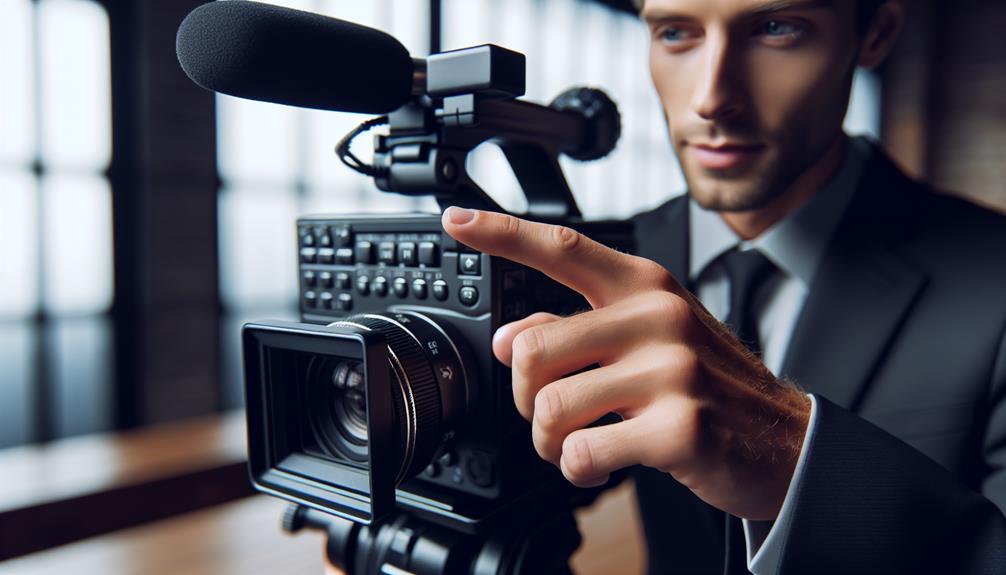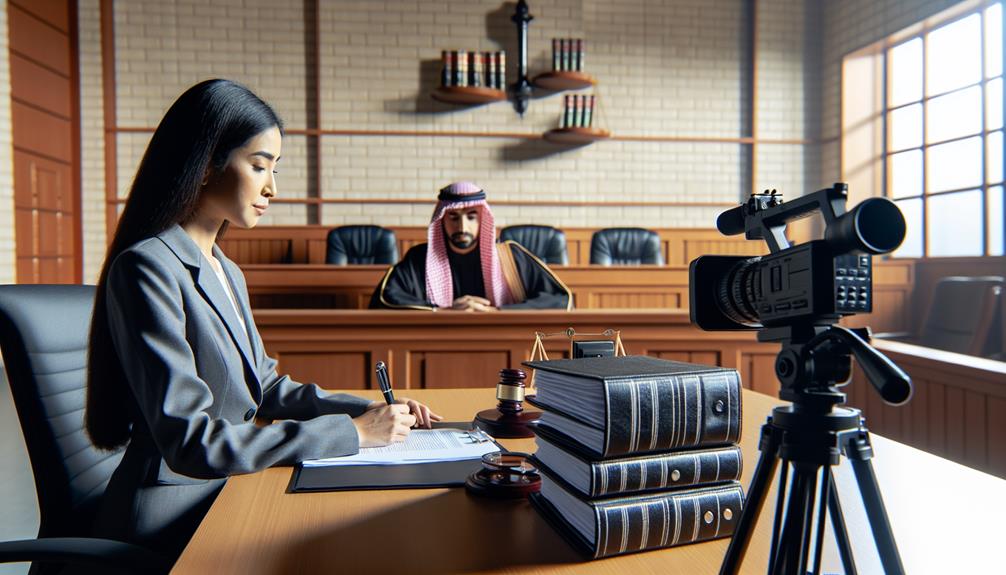As the camera starts rolling, the bright lights illuminate the room, casting long shadows across the table. It's my first video deposition, and I can feel the weight of the moment pressing down on me. How do I make sure I navigate this unfamiliar territory with confidence and success?
Luckily, I've compiled eight essential tips that will help me, and anyone in the same situation, prepare for their first video deposition. From knowing the purpose to presenting myself professionally, these tips will ensure a smooth and effective experience.
So, let's dive into the world of video depositions and discover how to make the best impression on screen.
Key Takeaways
- Video depositions capture emotions, body language, and nuances, making them more compelling than written records.
- Organizing necessary documents thoroughly and systematically demonstrates preparation and enhances witness credibility.
- Familiarizing yourself with the technology involved in video depositions minimizes disruptions and allows for proactive handling of technical difficulties.
- Practicing and improving your presentation, paying attention to body language and tone of voice, can enhance the effectiveness of your video deposition.
Know the Purpose

In order to effectively navigate a video deposition, it's crucial to fully understand and embrace its purpose. Understanding the significance of a video deposition allows us to approach it with clarity and purpose. It isn't just another step in the legal process; it's a powerful tool that can make or break a case. By recognizing its importance, we can establish clear objectives and make strategic decisions that will ultimately lead to success.
The purpose of a video deposition goes beyond simply recording testimony. It serves as a means to capture the emotions, body language, and nuances of a witness. By having a visual and auditory record of the deposition, we can present a more compelling case to the judge and jury. It allows us to highlight key moments, emphasize critical points, and challenge inconsistencies in a way that written transcripts alone cannot.
Furthermore, video depositions offer the opportunity for innovation and creativity in the courtroom. We can use technology to our advantage, incorporating graphics, animations, and demonstrative evidence to enhance our arguments. By fully understanding the purpose of a video deposition, we can leverage these tools to present a more persuasive case.
Gather Necessary Documents
To effectively gather necessary documents for a video deposition, I begin by compiling a comprehensive list of relevant materials. Document organization is key in ensuring a smooth and efficient deposition process. Before the deposition, I conduct thorough legal research to identify the specific documents that are essential to the case. This involves reviewing pleadings, contracts, correspondence, and any other relevant materials that may support or challenge the testimony of the witness.
Once I've identified the necessary documents, I create a system for organizing them. This may involve creating folders on my computer or using physical binders to keep hard copies. I label each document clearly and categorize them based on their relevance to specific topics or issues that will be discussed during the deposition.
Having well-organized documents not only allows for easy access and retrieval during the deposition but also helps in presenting a clear and persuasive case. It demonstrates thorough preparation and attention to detail, which can greatly enhance the credibility of the witness and the overall effectiveness of the deposition.
Familiarize Yourself With the Technology

Now that the necessary documents have been gathered and organized, it's essential to become familiar with the technology involved in conducting a video deposition. Understanding the equipment and being able to troubleshoot any potential issues that may arise can make a significant difference in the success of the deposition.
In today's fast-paced world, technology is constantly evolving, and it's crucial to stay updated and adapt to the latest advancements. As a legal professional, embracing technology can enhance your practice and streamline the deposition process. Familiarizing yourself with the video deposition equipment, such as cameras, microphones, and video conferencing software, will enable you to navigate the technology seamlessly.
To understand the equipment, take the time to review the user manuals and practice using the devices before the actual deposition. This won't only help you become comfortable with the technology but also allow you to troubleshoot any potential issues that may arise. Being proactive in familiarizing yourself with the technology will ensure that you can handle any technical difficulties swiftly and efficiently, minimizing disruptions during the deposition.
Practice Your Presentation
Practicing your presentation is a vital step in ensuring a smooth and confident delivery during the video deposition process. It isn't enough to simply know your material; you must also be able to effectively communicate it to others. Developing confidence in your presentation skills won't only improve your delivery, but it will also help you handle any unexpected challenges that may arise during the deposition.
To develop confidence, it's important to practice your presentation multiple times before the actual deposition. This will allow you to become familiar with the flow of your presentation and identify any areas that may need improvement. Additionally, practicing in front of a mirror or recording yourself can help you become aware of any unconscious habits or mannerisms that may distract from your message.
Improving your delivery involves more than just memorizing your lines. It's important to focus on your body language, tone of voice, and overall presence. Pay attention to your posture, maintain steady eye contact, and use gestures to emphasize key points. Practice speaking clearly and at an appropriate pace, and be mindful of any verbal fillers such as 'um' or 'like' that may detract from your message.
Dress and Appear Professionally

Dressing and presenting oneself professionally can greatly impact the impression you make during a video deposition. It's crucial to wear appropriate professional attire that reflects your seriousness and respect for the legal process. Choose clothing that's conservative, well-fitting, and free from distracting patterns or logos. Your appearance should convey competence and credibility.
In addition to professional attire, your body language also plays a significant role in how you're perceived. Maintain good posture, sit up straight, and make eye contact with the camera. Avoid fidgeting or slouching, as this can convey nervousness or lack of confidence. Show respect and attentiveness by nodding and actively listening to the questions being asked.
Remember that your appearance and body language can influence how the opposing counsel and the jury perceive your credibility and believability. By dressing and appearing professionally, you demonstrate your commitment to the case and your respect for the legal process. It shows that you take your role seriously and are prepared to present your case in a competent and persuasive manner.
Conclusion
In conclusion, preparing for your first video deposition can be a daunting task, but by following these essential tips, you can ensure a successful and professional experience.
Understanding the purpose, gathering necessary documents, familiarizing yourself with the technology, practicing your presentation, and dressing professionally are all key factors in making a strong impression.
By taking these steps, you can confidently navigate the video deposition process and effectively present your case.

